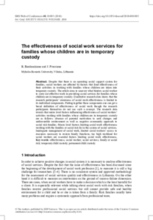Displaying 291 - 300 of 500
This brief documents the evaluation of an online training for Citizen Review Panel (CRP) members in one southeastern state in the United States.
The article aims to uncover what hinders social workers to carry out effective work in providing social services for families whose children are in temporary custody.
This article, based on a unique mixed‐methods study of social work interventions in the UK and the influence of poverty, highlights a narrative from practitioners that argues that, as many poor families do not harm their children, it is stigmatizing to discuss a link between poverty and child abuse and neglect.
This chapter from 'New Directions in Children’s Welfare' aims to discover the delicate dynamics of trust within the specific professional and service user relations in work with children and young people who are either Looked After or at risk of significant harm.
This chapter from 'New Directions in Children’s Welfare' applies the theorising emerging from mobilities discourses and applies them to children’s services.
This chapter from 'New Directions in Children’s Welfare' examines competing understandings of child welfare.
This chapter, from the book 'New Directions in Children’s Welfare,' explores the emotional and sensory dimensions of child welfare as an embodied practice which takes place across diverse sites, spaces and places.
The introductory chapter of 'New Directions in Children’s Welfare' starts with a reflection from the author’s personal experience of social work practice and working with a family where the children are neglected and on the child protection register as a result.
Within this chapter (from the book 'New Directions in Children’s Welfare,') three child abuse inquiry and Serious Case Review reports are explored to understand the contemporary landscape of Children’s Services and the ongoing challenges involved in protecting children and young people from harm.
The purpose of this study was to assess the perspective of social service providers who participated in a nine-month, trauma-informed care (TIC) training intervention on 1) their capacity to make referrals to trauma-specific services following the training, and 2) factors external to the training intervention that supported or hindered their ability to link traumatized youth with services.

